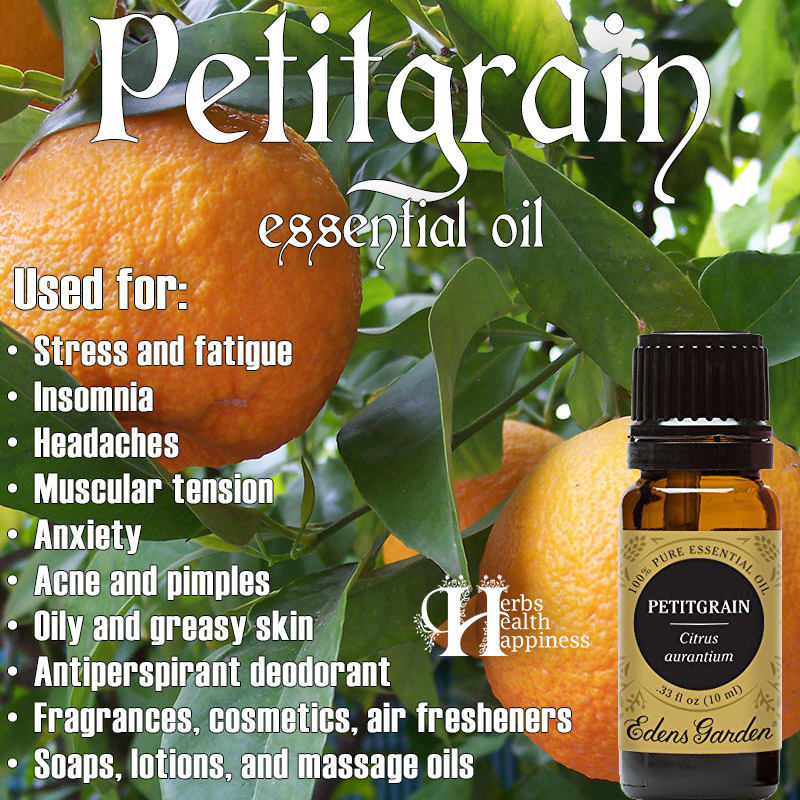
Petitgrain Essential Oil – Uses And Benefits – image to repin / share
Background pic – Wikipedia – lic. under CC 4.0
Essential oil pic – amazon.com (click here to buy)
Petitgrain Essential Oil – General Description
Petitgrain essential oil is extracted through steam distillation process from the leaves and green twigs of Citrus aurantium var. amara, a spiny evergreen variety of bitter orange native to Southeast Asia but is now widely cultivated throughout the Mediterranean and subtropical regions. The tree in general is used as grafting stock for citrus trees due to its tolerance to low temperatures and for making marmalades and orange-flavored liqueurs. [1]
Petitgrain derives its name from the small (“petit”) unripe fruits of the bitter orange tree, as originally, this essential oil was produced in distilleries where, instead of leaves and twigs, unripe oranges the size of cherries were used. Neroli, bitter orange, and petitgrain essential oils are distilled from the same plant species, but their distinction lies on their individually distinct aromas and on what part of the bitter orange tree they are extracted from: in the case of petitgrain essential oil, as earlier mentioned, it is yielded from the dark-green, leathery leaves and, occasionally, twigs and branches of the bitter orange tree, whereas neroli essential oil is derived from the white fragrant blossoms and bitter orange essential oil is usually cold-pressed or expressed from the citrus rinds or peels. [2]
The aroma of petitgrain essential oil is described as similar to orange blossoms but with bitter, floral, citrusy, and herbaceous undertones and relaxing and stimulating qualities. This crisp essential oil appears colorless and clear with a yellowish tinge and has a thin consistency and a watery viscosity. It blends superbly with bergamot, cedarwood, clary sage, geranium, lavender, lime, jasmine, neroli, orange, palmarosa, rosemary, sandalwood, and ylang-ylang essential oils.
Petitgrain – Uses and Reported Benefits
Petitgrain essential oil possesses uplifting, mentally refreshing, and emotionally balancing properties and is hence utilized in aromatherapy to alleviate stress and fatigue, calm the nerves, and help remedy cases of insomnia, headaches, muscular tension, and anxiety. It has been considered by some as an aphrodisiac that works delightfully as an addition to blends especially formulated for men.
Similar to its cousin, neroli essential oil, petitgrain essential oil has an affinity with the skin and is used in natural skin care formulations to get rid of acne, pimples, and blemishes and help with oily, greasy skin, where this essential oil stabilizes the degree of oil secretion of overactive sebaceous glands and serves as a versatile tonic to the complexion. [3] The essential oil is also an effective antiperspirant deodorant and astringent and is a common ingredient in fragrances, cosmetics, air fresheners, soaps, lotions, and diffuser or massage oils.
Petitgrain is less expensive than neroli and is sometimes added to neroli as an adulterant.
Petitgrain – Contraindications and Safety
Petitgrain essential oil is by and large regarded as nontoxic, safe, and non-irritant with no documented adverse reactions related to its use. However, caution must still be exercised, especially among sensitive individuals with established allergies to citrus essential oils. Pregnant and lactating women must first consult their physicians as regards essential oil use since not much has been investigated about the essential oil’s effect on this group. Petitgrain essential oil must be stored in a cool area unreachable by children.
Petitgrain – Scientific Studies And Research
Even before the introduction of the concept of steam distillation, the bitter orange tree and its various parts have been of value among habitants living in areas where they are grown and has been traditionally used for medicinal purposes on account of the tree’s anti-inflammatory, antibacterial, antispasmodic, sedative, and relaxant therapeutic properties. In central and south America, China, Haiti, Italy, and Mexico, for example, the tree’s leaves are orally administered as decoctions to treat colds, flu, fever, diarrhea, digestive spasm and indigestion, hemorrhages, infant colic, nausea and vomiting, and skin blemishes. [3]
The bitter orange tree has been repeatedly reported to possess numerous pharmacological actions. Its leaves and flowers in particular have been suggested by a few studies to exhibit potential anticancer, antispasmodic, sedative, and tranquilizing activities, although more research is required to strengthen the evidence for these properties. [4]
The radical scavenging activities of natural antioxidants in petitgrain essential oil has been of increasing interest in recent years, which may support this essential oil’s role in preventing a variety of chronic disorders. In the study of Lagha-Benamrouche and Madani (2013), bitter orange manifested the highest levels of total phenols and the highest capacity to slow the oxidation rate of linoleic acid and β-carotene, with petitgrain essential oil showing an antiradical activity of 58.48–92.55%. [5] Based on the study of Sarrou, Chatzopoulou, Dimassi-Theriou, and Therios (2013), petitgrain essential oil displayed the greatest antioxidant activity over neroli and bitter orange essential oils according to the results of the DPPH test. [6]
Results from a recent 2014 study of a research team from the University of Carthage, Tunisia, revealed the moderate antibacterial qualities of petitgrain essential oil. In this study, the tested bacteria, namely, Listeria monocytogenes ATCC 19111, Staphylococcus aureus ATCC 25923 (CIP7625), methicillin-resistant S. aureus, Escherichia coli ATCC 25922 (CIP 7624), Pseudomonas aeruginosa ATCC 27853 (CIP 76110), Salmonella typhimurium, Klebsiella pneumoniae ATCC 1388, and cefotaxime-resistant K. pneumoniae, were found sensitive to the essential oil. [5]
Petitgrain – Molecular Components and Chemistry
Petitgrain essential oil contains around 90% monoterpene hydrocarbons, alcohols, flavonoid glycosides, aldehydes, ketone-free acids, esters, coumarins, and tetranotriterpenoids. [6] Boussaada and Chemli (2006) examined the chemical composition of the essential oils derived from the flowers, leaves, and peels of Tunisian C. aurantium var. amara through gas chromatography with flame ionization detection (GC-FID) and gas chromatography–mass spectrometry (GC-MS). In this study, linalool (36.8%), linalyl acetate (22.1%), and α-terpineol (11.7%) were found to be the primary constituents of petitgrain essential oil. [5] In addition to the aforementioned compounds, geranyl acetate, neryl acetate, and trans-β-ocimene were also identified in the study of Sarrou, Chatzopoulou, Dimassi-Theriou, and Therios (2013). [6]
References:
[1] Saonere Suryawanshi J. A. (2011). An overview of Citrus aurantium used in treatment of various diseases. African Journal of Plant Sciences. 5(7): 390–395. https://academicjournals.org/article/article1380019714_Suryawanshi.pdf
[2] Petitgrain. Wikipedia. https://en.wikipedia.org/wiki/Petitgrain
[3] Lyth G. (2008). Petitgrain essential oil. Quinessence Aromatherapy.
https://quinessence.com/blog/petitgrain-essential-oil
[4] Arias B. A., Ramón-Laca L. (2005). Pharmacological properties of citrus and their ancient and medieval uses in the Mediterranean region. Journal of Ethnopharmacology. 97(1): 89–95. https://sciencedirect.com/science/article/pii/S0378874104005306
[5] Lagha-Benamrouche S., Madani K. (2013). Phenolic contents and antioxidant activity of orange varieties (Citrus sinensis L. and Citrus aurantium L.) cultivated in Algeria: Peels and leaves. Industrial Crops and Products. 50:723–730.
https://europepmc.org/abstract/AGR/IND500696655
[6] Sarrou E. et al. (2013). Volatile constituents and antioxidant activity of peel, flowers and leaf oils of Citrus aurantium L. growing in Greece. Molecules. 18: 10639–10647. doi:10.3390/molecules180910639. https://mdpi.com/1420-3049/18/9/10639
[7] Trabelsi D., Haj Ammar A., Bouabdallah F., Zagrouba F. (2014). Antioxidant and antimicrobial activities of essential oils and methanolic extracts of Tunisian Citrus aurantium L. IOSR Journal of Environmental Science, Toxicology and Food Technology. 8(5): 18–27.
https://iosrjournals.org/iosr-jestft/papers/vol8-issue5/Version-2/D08521827.pdf
[8] Bitter orange. Drugs.com. https://drugs.com/npp/bitter-orange.html
[9] Boussaadaa O., Chemlia R. (2006). Chemical composition of essential oils from flowers, leaves and peel of Citrus aurantium L. var. amara from Tunisia. Journal of Essential Oil Bearing Plants. 9(2): 133–139.
https://tandfonline.com/doi/abs/10.1080/0972060X.2006.10643484#preview

★ Get My Books - 100% FREE:
😳 Tinnitus And Brain Health?
After 47 years of studies and countless brain scans done on more than 2,400 tinnitus patients, scientists at the MIT Institute found that in a shocking 96% of cases, tinnitus was actually shrinking their brain cells.
As it turns out, tinnitus and brain health are strongly linked.
Even more interesting: The reason why top army officials are not deaf after decades of hearing machine guns, bombs going off and helicopter noises…
Is because they are using something called "the wire method", a simple protocol inspired by a classified surgery on deaf people from the 1950s...
★ How To Get Rid Of Nail Fungus:
★ Does Your Salad Contain This Vegetable?
★ 20 Natural Painkillers In Your Kitchen (Video):
★ Men's Prostate Health:

2. Famous Chef Sheds 60lbs Researching New Paleo Recipes: Get The Cookbook FREE Here
3. #1 muscle that eliminates joint and back pain, anxiety and looking fat
4. 7 odd foods that KILL your abdominal fat (surprising fat-fighters)
5. The TRUTH about bread (Will surprise you!)
6. [PROOF] Reverse Diabetes with a "Pancreas Jumpstart"
7. Here's What Happens When You "Unlock Your Hip Flexors"
8. The #1 WORST food that CAUSES Faster Aging (beware -- Are you eating this?)
The #1 Muscle That Eliminates Joint And Back Pain, Anxiety And Looking Fat
By Mike Westerdal CPT
Can you guess which muscle in your body is the #1 muscle that eliminates joint and back pain, anxiety and looking fat?
This is especially important if you spend a significant amount of time sitting every day (I do, and this really affects me in a big way!)
Working this "hidden survival muscle" that most people are simply not training because no-one ever taught them how will boost your body shape, energy levels, immune system, sexual function, strength and athletic performance when unlocked.
If this "hidden" most powerful primal muscle is healthy, we are healthy.
Is it...
a) Abs
b) Chest
c) Glutes
d) Hip Flexors
Take the quiz above and see if you got the correct answer!
P.S. Make sure you check out this page to get to know the 10 simple moves that will bring vitality back into your life:
If you enjoyed this page:














